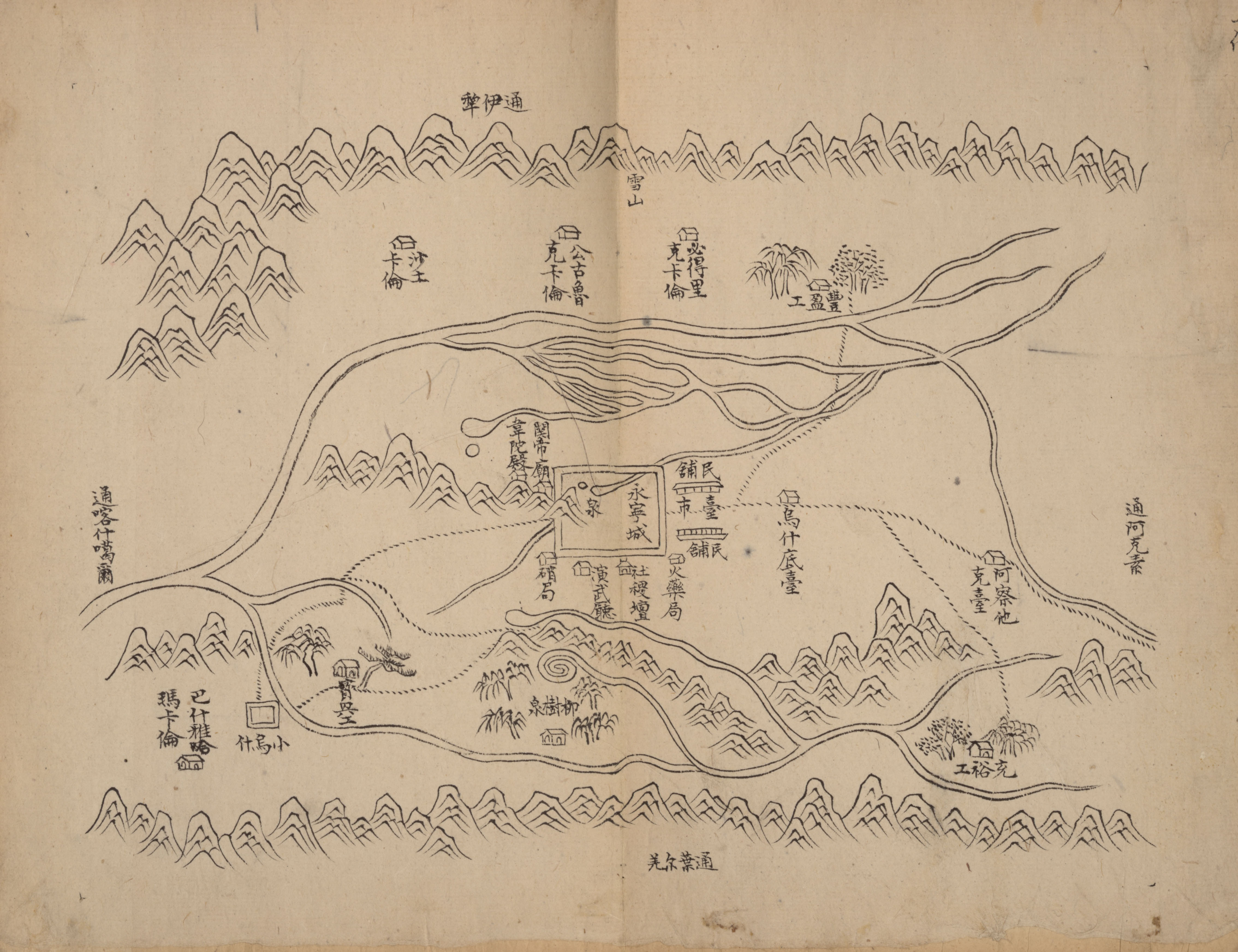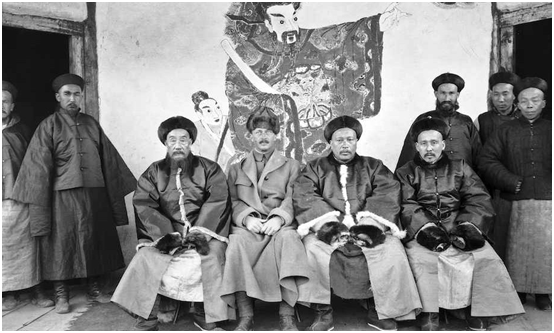|
Sultan Said Khan
Sultan Said Khan (; 1487–1533) ruled the Yarkent Khanate from September 1514 to July 1533. He was born in the late 15th century in Moghulistan, and he was a direct descendant of the first Moghul Khan, Tughlugh Timur, who had founded the state of Moghulistan in 1348 and ruled until 1363. The Moghuls were turkicized Mongols who had converted to Islam. Some English sources refer to this ruler as Abusaid. Background When the Chagatai ''ulus'', which embraced both East and West Turkestan, collapsed, the result was the creation of two different states: ''Maverannahr'' in West Turkestan, with its capital at Samarkand, where Timur the Great came to power in 1370, and Moghulistan, with its capital at Almalik, near the present-day town of Gulja, in the Ili valley. Moghulistan embraced settled lands in Eastern Turkestan as well as nomad lands north of '' Tangri Tagh''. The settled lands were known at the time as ''Manglai Sobe'' or ''Mangalai Suyah'', which translates as ... [...More Info...] [...Related Items...] OR: [Wikipedia] [Google] [Baidu] |
Mansur Khan (Moghul Khan)
Mansur Khan (1482/3–1543) (; chg, منصور خان}), was the last khan of a united Moghulistan from 1503 until his death. From his father Ahmad Alaq, the previous khan, he inherited the eastern parts of Moghulistan proper ( Yili area), the Muslim oasis cities of Yanqi, Baicheng, and Kuche, and the Buddhist "Uighur" holdout of Turfan. He also led a jihad of conquest against Oirat Mongol and Chinese territories to the east, including Hami and Dunhuang, and attempted to convert the Kyrgyz to Islam. Following his death, the khanate was permanently divided into Western and Eastern portions which would themselves eventually devolve into smaller states. Life When he was nineteen, Mansur was made khan by his father, who departed to join his brother Mahmud Khan in a campaign against the Shaybanid Uzbeks of Transoxiana. The campaign ended in disaster, as both Ahmad and Mahmud were captured. They were released but Ahmad died shortly after in Aksu. Following Ahmad's death, Mans ... [...More Info...] [...Related Items...] OR: [Wikipedia] [Google] [Baidu] |
Turkestan
Turkestan, also spelled Turkistan ( fa, ترکستان, Torkestân, lit=Land of the Turks), is a historical region in Central Asia corresponding to the regions of Transoxiana and Xinjiang. Overview Known as Turan to the Persians, western Turkestan has also been known historically as Sogdia, "Ma wara'u'n-nahr" (by its Arab conquerors), and Transoxiana by western travelers. The latter two names refer to its position beyond the River Oxus when approached from the south, emphasizing Turkestan's long-standing relationship with Iran, the Persian Empires, and the Umayyad and Abbasid Caliphates. Oghuz Turks (also known as Turkmens), Kyrgyzs, Uzbeks, Kazakhs, Khazars, Uyghurs and Hazaras are some of the Turkic inhabitants of the region who, as history progressed, have spread further into Eurasia forming such Turkic nations as Turkey, and subnational regions like Tatarstan in Russia and Crimea in Ukraine. Tajiks and Russians form sizable non-Turkic minorities. It is subdivided into ... [...More Info...] [...Related Items...] OR: [Wikipedia] [Google] [Baidu] |
Uqturpan County
Uqturpan County, United States National Geospatial-Intelligence Agency or Uchturpan County ( transliterated from ; ), also Wushi County (), is a county in the Xinjiang Uyghur Autonomous Region under the administration of Aksu Prefecture and shares an approximately long border with Kyrgyzstan's Issyk-Kul Region. The county is bordered to the northeast by Onsu County (Wensu), to the southeast by Aksu city, to the west by Akqi County in Kizilsu Kyrgyz Autonomous Prefecture and to the south by Kalpin County (Keping). It has an area of and a population of 180,000. Name Uqturpan is also spelled Uchturpan and Uch-Turfan. History Tang During the Battle of Aksu (717), the Umayyad Caliphate and their Turgesh and Tibetan Empire allies hope to seize Uqturpan (then known as Dai-dʑiᴇk-dʑiᴇŋ) from Tang-Karluks- Exiled Western Turkic Khaganate allies but were repelled. Qing Ush Turfan was the site of a battle between Barhanuddin and Abdulla during the Revolt of the Altishahr ... [...More Info...] [...Related Items...] OR: [Wikipedia] [Google] [Baidu] |
Aksu, Xinjiang
Aksu is a city in and the seat of Aksu Prefecture, Xinjiang, lying at the northern edge of the Tarim Basin. The name Aksu literally means "white water" (in Turkic) and is used for both the oasis town and the Aksu River. The economy of Aksu is mostly agricultural, with cotton, in particular long-staple cotton (''Gossypium hirsutum''), as the main product. Also produced are grain, fruits, oils and beets. The industry mostly consists of weaving, cement and chemical industries. The land currently under the administration of the Aksu City is divided in two parts, separated by the Aral City. The northern part hosts the city center, while the southern part is occupied by the Taklamakan Desert. Aksu airport is considered a military airport in China (although also available for civil usage). Only aircraft registered in China can land in Aksu. This means if you are flying to Aksu from international origins you have to land in a major airport in China like Beijing, Shanghai, Guangzhou a ... [...More Info...] [...Related Items...] OR: [Wikipedia] [Google] [Baidu] |
Kashgar
Kashgar ( ug, قەشقەر, Qeshqer) or Kashi ( zh, c=喀什) is an oasis city in the Tarim Basin region of Southern Xinjiang. It is one of the westernmost cities of China, near the border with Afghanistan, Kyrgyzstan, Tajikistan and Pakistan. With a population of over 500,000, Kashgar has served as a trading post and strategically important city on the Silk Road between China, the Middle East and Europe for over 2,000 years, making it one of the oldest continuously inhabited cities in the World. At the convergence point of widely varying cultures and empires, Kashgar has been under the rule of the Chinese, Turkic, Mongol and Tibetan empires. The city has also been the site of a number of battles between various groups of people on the steppes. Now administered as a county-level unit, Kashgar is the administrative center of Kashgar Prefecture, which has an area of and a population of approximately 4 million as of 2010. The city itself has a population of 506,640, and its ... [...More Info...] [...Related Items...] OR: [Wikipedia] [Google] [Baidu] |
Yengisar County
Yengisar County, United States National Geospatial-Intelligence Agency (also known as Yangi Hissar); via Mandarin Chinese known as Yingjisha, United States National Geospatial-Intelligence Agency (Ying-chi-sha), is a county in the southwest of the Xinjiang Uyghur Autonomous Region. It is under the administration of the Kashgar Prefecture. It contains an area of . As of the 2002 census, it had a population of 230,000. The county seat is the city of Yengisar, a town that is best known among the local Uyghurs for its handmade knives. The finely-tuned skill of knife making used to be passed down among generations in Yengisar, but is slowly dying due to China's strict response to deadly clashes in the Xinjiang region. History In 1499, Ahmad Alaq seized Kashgar and Yengisar from Mirza Abu Bakr Dughlat. In 1847 and again in 1857, Kashgar and Yengisar were captured. In 1882, Yengisar ''Zhili Ting'' () was created. In 1913, Yengisar ''Zhili Ting'' became Yengisar County. The Battle ... [...More Info...] [...Related Items...] OR: [Wikipedia] [Google] [Baidu] |
Yarkant County
Yarkant County,, United States National Geospatial-Intelligence Agency also Shache County,, United States National Geospatial-Intelligence Agency also transliterated from Uyghur as Yakan County, is a county in the Xinjiang Uyghur Autonomous Region, China, located on the southern rim of the Taklamakan Desert in the Tarim Basin. It is one of 11 counties administered under Kashgar Prefecture. The county, usually referred to as Yarkand in English, was the seat of an ancient Buddhist kingdom on the southern branch of the Silk Road and the Yarkand Khanate. The county sits at an altitude of and had a population of . The fertile oasis is fed by the Yarkand River, which flows north down from the Karakorum mountains and passes through the Kunlun Mountains, known historically as the Congling mountains (lit. 'Onion Mountains' - from the abundance of wild onions found there). The oasis now covers , but was likely far more extensive before a period of desiccation affected the reg ... [...More Info...] [...Related Items...] OR: [Wikipedia] [Google] [Baidu] |
Hotan
Hotan (also known as Gosthana, Gaustana, Godana, Godaniya, Khotan, Hetian, Hotien) is a major oasis town in southwestern Xinjiang, an autonomous region in Western China. The city proper of Hotan broke off from the larger Hotan County to become an administrative area in its own right in August 1984. It is the seat of Hotan Prefecture. With a population of 408,900 (2018 census), Hotan is situated in the Tarim Basin some southwest of the regional capital, Ürümqi. It lies just north of the Kunlun Mountains, which are crossed by the Sanju, Hindutash and Ilchi passes. The town, located southeast of Yarkant County and populated almost exclusively by Uyghurs, is a minor agricultural center. An important station on the southern branch of the historic Silk Road, Hotan has always depended on two strong rivers—the Karakash River and the White Jade River to provide the water needed to survive on the southwestern edge of the vast Taklamakan Desert. The White Jade River stil ... [...More Info...] [...Related Items...] OR: [Wikipedia] [Google] [Baidu] |
Tarim Basin
The Tarim Basin is an endorheic basin in Northwest China occupying an area of about and one of the largest basins in Northwest China.Chen, Yaning, et al. "Regional climate change and its effects on river runoff in the Tarim Basin, China." Hydrological Processes 20.10 (2006): 2207–2216.online 426 KB) Located in China's Xinjiang region, it is sometimes used synonymously to refer to the southern half of the province, or Nanjiang (), as opposed to the northern half of the province known as Dzungaria or Beijiang. Its northern boundary is the Tian Shan mountain range and its southern boundary is the Kunlun Mountains on the edge of the Tibetan Plateau. The Taklamakan Desert dominates much of the basin. The historical Uyghur name for the Tarim Basin is Altishahr ( Traditional spelling: 六城 or ), which means 'six cities' in Uyghur. Geography and relation to Xinjiang Xinjiang consists of two main geographically, historically, and ethnically distinct regions with different h ... [...More Info...] [...Related Items...] OR: [Wikipedia] [Google] [Baidu] |
Ili River
The Ili ( ug, ئىلى دەرياسى, Ili deryasi, Ili dəryasi, 6=Или Дәряси; kk, Ile, ; russian: Или; zh, c=伊犁河, p=Yīlí Hé, dng, Йили хә, Xiao'erjing: اِلِ حْ; mn, Ил, literally "Bareness") is a river situated in Northwest China and Southeastern Kazakhstan. It flows from the Ili Kazakh Autonomous Prefecture of the Xinjiang Uighur Autonomous Region to the Almaty Region in Kazakhstan. It is long (including its source river Tekes),Или of which is in Kazakhstan. The river originates from the Tekes and Künes rivers in Eastern [...More Info...] [...Related Items...] OR: [Wikipedia] [Google] [Baidu] |
Yining (city)
YiningThe official spelling according to (), also known as Ghulja ( ug, غۇلجا) or Qulja ( kk, قۇلجا) and formerly Ningyuan (), is a county-level city in Northwestern Xinjiang, People's Republic of China and the seat of the Ili Kazakh Autonomous Prefecture. Historically, Yining is the successor to the ruined city of Almaliq in neighbouring Huocheng County. Yining is the third largest city in Xinjiang after Ürümqi and Korla. Area and population The city of Yining is a county-level administrative unit located along Ili River. As of 2015, it has an estimated population of 542,507, with a total land area of . It is the most populous city in the Ili Kazakh Autonomous Prefecture. The land area and population of the City of Yining saw an increase in 2003; the increase resulted from the transfer of two villages with some of land from the adjacent Yining County, which is a separate administrative unit from the city. History Note on historical place names From 13-1 ... [...More Info...] [...Related Items...] OR: [Wikipedia] [Google] [Baidu] |



_of_Kashgar%2C_73_CE.jpg)
.jpg)



